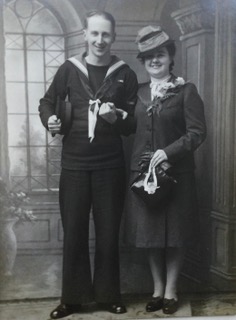
Menu
- 10am - 4pm, Mon to Sat
- Adults: £8 Under 18s: £4
- Under 12s/members: FREE
- Pensioners/students £7
- Birchburn, Scotland
- 01445 731137
- JustGiving

Contributed by his son Lionel Macham in December 2023
Mark had never been to sea when the Second World war began. He had trained as a tailor and cutter and was the manager of an outfitters’ shop. But seafaring had played a great part of his family’s history. His mother came from Itchen Ferry, a village near Southampton where for hundreds of years generation after generation of the menfolk had been seamen. Mark’s grandfather was a fisherman all his life and his five uncles all went to sea. Between them they had sailed the world, served in the Merchant Navy in the First World War and skippered racing yachts.
Mark joined the Royal Navy in March 1941 and his first active posting was on board HMS Scylla, a newly built cruiser. He joined the ship during sea trials in the Clyde and then she sailed to Scapa Flow to be deployed for convoy defence work. In September 1942 she was the flagship for Russian Convoy PQ18. This included collecting about 200 survivors of the previous convoy, PQ17, which had suffered severe losses. This must have been a bleak reminder of the risks involved for all Russian convoys. The ship was visited by Winston Churchill at Scapa Flow when Mark is pictured (just) in a newspaper photograph among the crew being inspected by the wartime leader.
The next major conflict that HMS Scylla participated in was Operation Torch in November 1942: the Allied invasion of North Africa. Her part in this was that at the end of October she had sailed to Gibraltar, having collected Admiral Cunningham, the Naval Commander for the Allied campaign, at Plymouth. In November and December 1942 she was part of the eastern task force operating out of Algiers, covering troop landings, defending Allied convoys and attacking enemy ships.
Then she returned to Britain and was refitted on the Tyne in early 1943 including modifications for Arctic service. In February she sailed for Iceland to join the Russian Convoy JW53 but in March was reassigned to the Home Fleet. When King George VI visited Scapa Flow, he was returned to the mainland on board the Scylla.
The Scylla remained in the Atlantic and the English Channel during the spring and summer of 1943, defending Allied convoys and attacking enemy submarines. When Churchill crossed the Atlantic to attend the Trident conference of wartime leaders in Canada, Scylla escorted his ship, the Queen Mary.
In August 1943 HMS Scylla was transferred to the Mediterranean where she assisted in the supply and defence of Malta, which had been besieged by the enemy. She then sailed for Salerno in Italy where she participated in the Allied landings in September 1943: the start of the invasion of mainland Italy and southern Europe.
She returned to Devonport for repair and conversion for use as an Escort Carrier Flagship and was recommissioned as part of the Home Fleet. During the Normandy landings in June 1944 (D-day: the beginning of the Allied invasion of northern Europe) she was an Allied Flagship, carrying Admiral Vian, the commanding officer of the eastern task force. She supported the landings at Sword beach by bombarding the German defences as well as defending troops against attack. But a few days later she was severely damaged when she hit a mine and had to be towed to Chatham. It was decided that it would be uneconomic to repair her.
The remainder of Mark’s service seems to have been spent largely ashore. He was first posted to HMS Victory/Stamshaw Camp. Then during 1945 he was based at other shore establishments: HMS Vernon, HMS Calliope and HMS Cochrane. His service record also lists him with the aircraft carrier HMS Perseus but before its commissioning in October 1945. Mark expected to be posted to the Far East as the war with Japan had not ended (perhaps with the Perseus) but he was discharged from the Royal Navy on 14 November 1945.
He came through the war with no more than minor injuries. He spoke very little of his wartime service and tended to laugh off what must have been a gruelling period of his life, not helped by a vulnerability to sea sickness. He married shortly after returning home to Southampton and returned to work as a manager of a menswear shop. He died in 1993.
He received the following medals:
1939-45 Star,
Africa Star
North Africa 1942-3 clasp
Atlantic Star
Italy Star
France and Germany clasp
He also received the 40th anniversary Russian commemorative medal and in 2018 I successfully applied on his behalf for the Arctic Star. We also have a few artefacts including his Order of the Bluenose certificate, issued in 1942 when he crossed the Arctic Circle, a brooch of HMS Scylla, worn by his mother and his torpedoman’s badge.
Notes on the images
1 The best photograph we have of Mark in naval uniform is on his wedding day in March 1945. His bride was Joan Harvey who herself had a stressful war. (As well as worrying about Mark, the area where she lived and worked was subjected to many bombing raids because it included the Woolston Spitfire Factory, destroyed by German air raids with considerable loss of life.)
2 A photograph of HMS Scylla.
3 Mark’s medals including the Russian one, his mother’s Scylla brooch and his torpedoman badge.
4 Mark’s Bluenose certificate.
5 Three photographs on board the Scylla: one with men at their posts (Mark is second right), one relaxed picture (Mark is on the left) and one picture in warmer climes with no heavy coats (Mark is 4th right).
6 A cutting from the Daily Sketch recording the visit of Winston Churchill in 1942. Someone has written: are you in this and there is a cross marked to indicate his position.
Click to expand photos